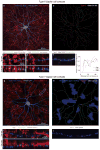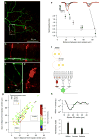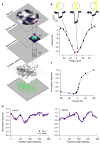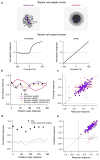The spatial structure of a nonlinear receptive field
- PMID: 23001060
- PMCID: PMC3517818
- DOI: 10.1038/nn.3225
The spatial structure of a nonlinear receptive field
Abstract
Understanding a sensory system implies the ability to predict responses to a variety of inputs from a common model. In the retina, this includes predicting how the integration of signals across visual space shapes the outputs of retinal ganglion cells. Existing models of this process generalize poorly to predict responses to new stimuli. This failure arises in part from properties of the ganglion cell response that are not well captured by standard receptive-field mapping techniques: nonlinear spatial integration and fine-scale heterogeneities in spatial sampling. Here we characterize a ganglion cell's spatial receptive field using a mechanistic model based on measurements of the physiological properties and connectivity of only the primary excitatory circuitry of the retina. The resulting simplified circuit model successfully predicts ganglion-cell responses to a variety of spatial patterns and thus provides a direct correspondence between circuit connectivity and retinal output.
Figures








Similar articles
-
Spontaneous activity promotes synapse formation in a cell-type-dependent manner in the developing retina.J Neurosci. 2012 Apr 18;32(16):5426-39. doi: 10.1523/JNEUROSCI.0194-12.2012. J Neurosci. 2012. PMID: 22514306 Free PMC article.
-
Nonlinear spatial integration in the receptive field surround of retinal ganglion cells.J Neurosci. 2014 May 28;34(22):7548-61. doi: 10.1523/JNEUROSCI.0413-14.2014. J Neurosci. 2014. PMID: 24872559 Free PMC article.
-
Functional circuitry of the retinal ganglion cell's nonlinear receptive field.J Neurosci. 1999 Nov 15;19(22):9756-67. doi: 10.1523/JNEUROSCI.19-22-09756.1999. J Neurosci. 1999. PMID: 10559385 Free PMC article.
-
Features and functions of nonlinear spatial integration by retinal ganglion cells.J Physiol Paris. 2013 Nov;107(5):338-48. doi: 10.1016/j.jphysparis.2012.12.001. Epub 2012 Dec 20. J Physiol Paris. 2013. PMID: 23262113 Review.
-
Distinct synaptic mechanisms create parallel S-ON and S-OFF color opponent pathways in the primate retina.Vis Neurosci. 2014 Mar;31(2):139-51. doi: 10.1017/S0952523813000230. Epub 2013 Jul 29. Vis Neurosci. 2014. PMID: 23895762 Free PMC article. Review.
Cited by
-
Organization and emergence of a mixed GABA-glycine retinal circuit that provides inhibition to mouse ON-sustained alpha retinal ganglion cells.Cell Rep. 2021 Mar 16;34(11):108858. doi: 10.1016/j.celrep.2021.108858. Cell Rep. 2021. PMID: 33730586 Free PMC article.
-
Inferring nonlinear neuronal computation based on physiologically plausible inputs.PLoS Comput Biol. 2013;9(7):e1003143. doi: 10.1371/journal.pcbi.1003143. Epub 2013 Jul 18. PLoS Comput Biol. 2013. PMID: 23874185 Free PMC article.
-
Synaptic Convergence Patterns onto Retinal Ganglion Cells Are Preserved despite Topographic Variation in Pre- and Postsynaptic Territories.Cell Rep. 2018 Nov 20;25(8):2017-2026.e3. doi: 10.1016/j.celrep.2018.10.089. Cell Rep. 2018. PMID: 30463000 Free PMC article.
-
Inferring hidden structure in multilayered neural circuits.PLoS Comput Biol. 2018 Aug 23;14(8):e1006291. doi: 10.1371/journal.pcbi.1006291. eCollection 2018 Aug. PLoS Comput Biol. 2018. PMID: 30138312 Free PMC article.
-
Probing Computation in the Primate Visual System at Single-Cone Resolution.Annu Rev Neurosci. 2019 Jul 8;42:169-186. doi: 10.1146/annurev-neuro-070918-050233. Epub 2019 Mar 11. Annu Rev Neurosci. 2019. PMID: 30857477 Free PMC article. Review.
References
-
- Chichilnisky EJ. A simple white noise analysis of neuronal light responses. Network. 2001;12:199–213. - PubMed
Publication types
MeSH terms
Substances
Grants and funding
LinkOut - more resources
Full Text Sources
Other Literature Sources

